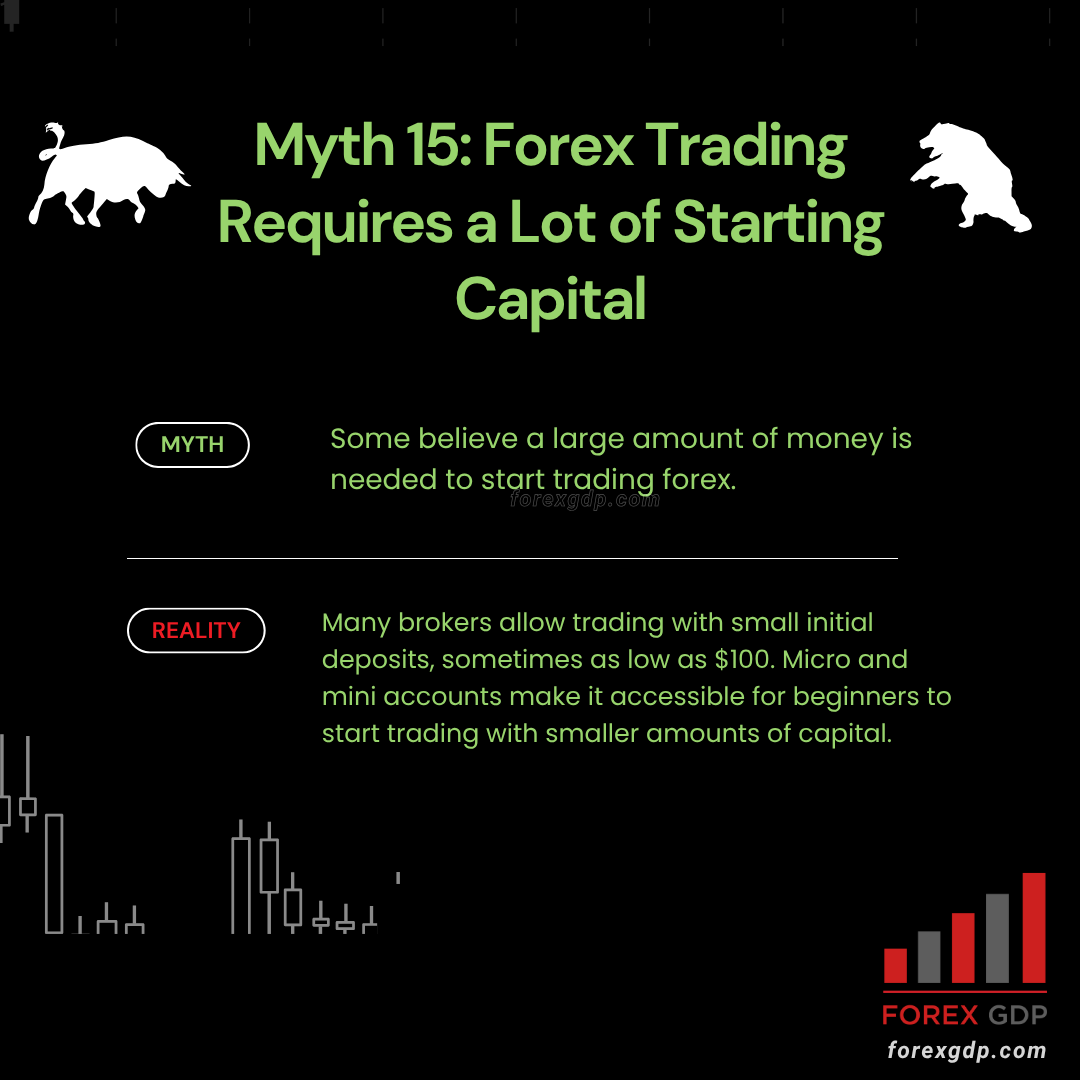Forex trading is surrounded by countless myths, and one of the most persistent is that you need a huge amount of money to even get started. Many beginners stay away because they believe trading is something only the wealthy can afford. But is that really true? Not at all.
In this article, we’ll dive deep into the truth behind this myth. We’ll break it down step by step—explaining how much you actually need to start, why brokers have made trading more accessible, and how you can grow even a small account into something significant. Let’s uncover the reality together.
Understanding the Myth of “Big Capital”
For years, Forex was seen as an elite game. Before online trading platforms existed, large banks, hedge funds, and institutional investors dominated the market. Back then, having a six-figure account was the norm.
This historical reality is why the myth stuck around. People assumed that to compete in the global currency market, they’d need massive resources. But times have changed, and this belief is outdated.
The Reality: Small Accounts Can Start Trading
Today, many brokers allow you to start trading with as little as $100. Some even go lower, offering micro or nano accounts that let you trade with just a few dollars.
Why the shift? Technology has opened the doors for retail traders. Platforms now connect individuals directly to the Forex market without needing a middleman. Combine that with competitive leverage options, and trading small amounts has become practical and profitable.
How Brokers Make Forex Accessible
Modern brokers have created multiple account types to cater to different budgets. Here’s how:
-
Micro Accounts – Trade with as little as $10-$50. Perfect for testing strategies.
-
Mini Accounts – Start with $100-$500 and take slightly larger positions.
-
Standard Accounts – Require $1,000+, typically for experienced traders.
By offering flexible accounts and leverage, brokers have dismantled the barriers to entry that once kept beginners away.
The Power of Leverage
One of the key reasons you don’t need a large starting balance is leverage.
Leverage allows you to control a much larger position with a small amount of money. For example:
-
With 1:100 leverage, your $100 deposit can control $10,000 worth of currency.
-
With 1:500 leverage, your $100 can control $50,000 worth of currency.
Of course, leverage is a double-edged sword—it can magnify both profits and losses. But when used wisely, it allows small accounts to grow steadily over time.
Starting Small is Actually Smarter
Many beginners think they need to deposit thousands to see real results. But starting small has advantages:
-
Lower risk exposure – Losing $100 hurts less than losing $10,000.
-
Learning opportunity – You can test strategies in live conditions without significant risk.
-
Confidence building – Small wins create the discipline and patience needed for larger accounts.
By treating small accounts as a training ground, you set yourself up for success later on.
The Right Mindset for Growing Small Accounts
If you’re starting with a small account, your focus shouldn’t be on making big profits instantly. Instead:
-
Prioritize consistency over size
-
Aim for small, steady percentage gains
-
Reinvest your profits to grow the account over time
Think of it like planting a seed. With the right care, patience, and strategy, your small account can grow into something substantial.
Common Mistakes Traders Make with Small Accounts
Starting with less money doesn’t mean you’re immune to errors. Here are the mistakes you need to avoid:
-
Over-leveraging – Using high leverage without risk control leads to blown accounts.
-
Revenge trading – Trying to recover losses quickly often causes bigger losses.
-
Ignoring risk management – Trading without stop-loss orders is a recipe for disaster.
-
Unrealistic expectations – Expecting to turn $100 into $10,000 overnight sets you up for failure.
Avoiding these pitfalls is key to protecting your capital and building confidence.
Smart Risk Management for Small Accounts
Risk management is the backbone of successful trading. Here’s a simple approach:
-
Risk no more than 1-2% of your account on a single trade.
-
Use stop-loss orders to prevent catastrophic losses.
-
Stick to a risk-reward ratio of at least 1:2, meaning you aim to make twice what you risk.
Even with a small account, proper risk management ensures your capital lasts long enough to learn and grow.
Strategies to Grow a Small Account
If you’re serious about scaling up, here are strategies that work:
-
Compound your profits – Reinvest earnings instead of withdrawing them early.
-
Focus on high-probability setups – Trade less, but aim for quality trades.
-
Use demo accounts for practice – Sharpen your strategy without risking real money.
-
Stay patient – Remember, trading is a marathon, not a sprint.
Consistency beats luck every time.
Tools and Platforms That Help Small Traders
Modern technology has leveled the playing field for small traders. Here are some tools that make a difference:
-
User-friendly platforms like MetaTrader 4 and 5 – Easy to learn and packed with indicators.
-
Mobile trading apps – Trade on the go with full market access.
-
Educational resources – Many brokers offer free webinars, e-books, and tutorials.
With these tools, even traders with minimal experience and small budgets can compete effectively.
The Psychological Edge of Starting Small
Trading isn’t just about charts and numbers—it’s also about your mindset.
Starting small helps you:
-
Trade with less stress since less money is at stake.
-
Build discipline without the fear of losing large sums.
-
Focus on learning and improving rather than chasing big wins.
This psychological edge can be the difference between long-term success and early burnout.
How to Choose the Right Broker for Small Accounts
Not all brokers are created equal. Here’s what to look for:
-
Low minimum deposits – So you can start with a comfortable amount.
-
Reasonable leverage – Enough to grow your account without excessive risk.
-
Tight spreads and low fees – Costs matter when trading small positions.
-
Reliable platform and customer support – Technical issues can be costly, so reliability is key.
Doing your homework upfront saves you from headaches later.
The Bottom Line
The belief that Forex trading requires a large amount of starting capital is nothing but a myth. In reality, thanks to micro accounts, leverage, and accessible platforms, almost anyone can begin with as little as $100.
But here’s the catch: small accounts require discipline, smart risk management, and realistic expectations. Start small, learn the ropes, and let time and consistency work in your favor. Remember, even the biggest oak tree started from a tiny seed.
Conclusion
Forex trading doesn’t have to be an exclusive club for the wealthy. With today’s technology and broker options, you can dip your toes into the market with a small amount of capital and grow over time. The key is to focus less on the size of your account and more on building strong trading habits, practicing sound risk management, and staying patient.
Treat trading as a skill you develop, not a lottery ticket. Start small, trade smart, and watch your trading journey flourish step by step.
FAQs
1. Can I really start Forex trading with just $100?
Yes! Many brokers offer micro and mini accounts that let you start with deposits as low as $100, making it easy for beginners to get started.
2. How much money do I need to make a full-time income from Forex?
It depends on your strategy and consistency. While you can start small, building a full-time income typically requires gradually growing your account over time.
3. Is high leverage good or bad for small accounts?
Leverage can be helpful but dangerous if misused. Stick to moderate leverage levels and practice strict risk management to avoid blowing your account.
4. Should I practice with a demo account first?
Absolutely. Demo accounts help you learn strategies and understand market behavior without risking real money.
5. How long does it take to grow a small Forex account?
There’s no fixed timeline. With discipline and consistent growth, many traders see meaningful progress within 6-12 months, but patience and strategy are crucial.




